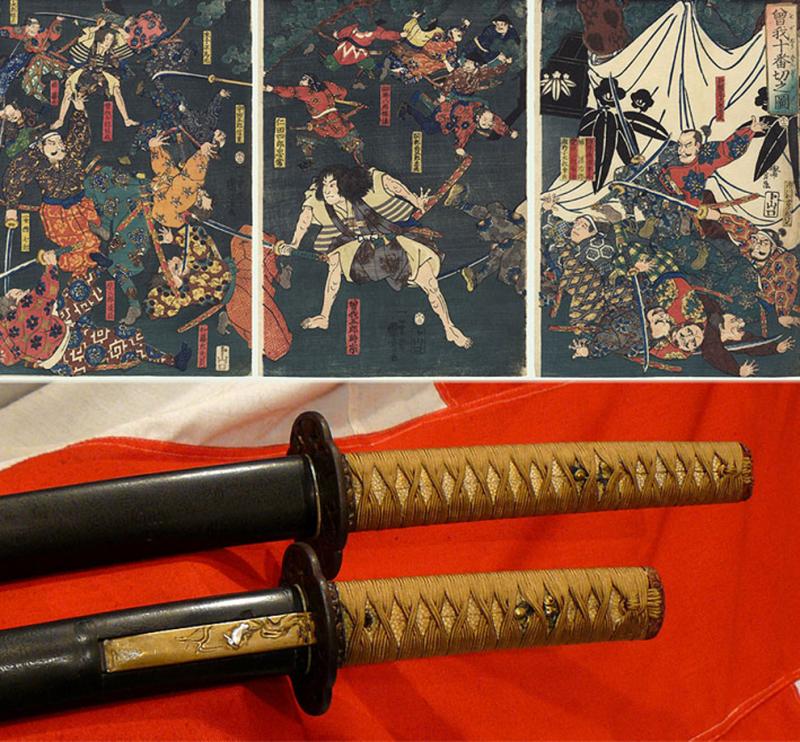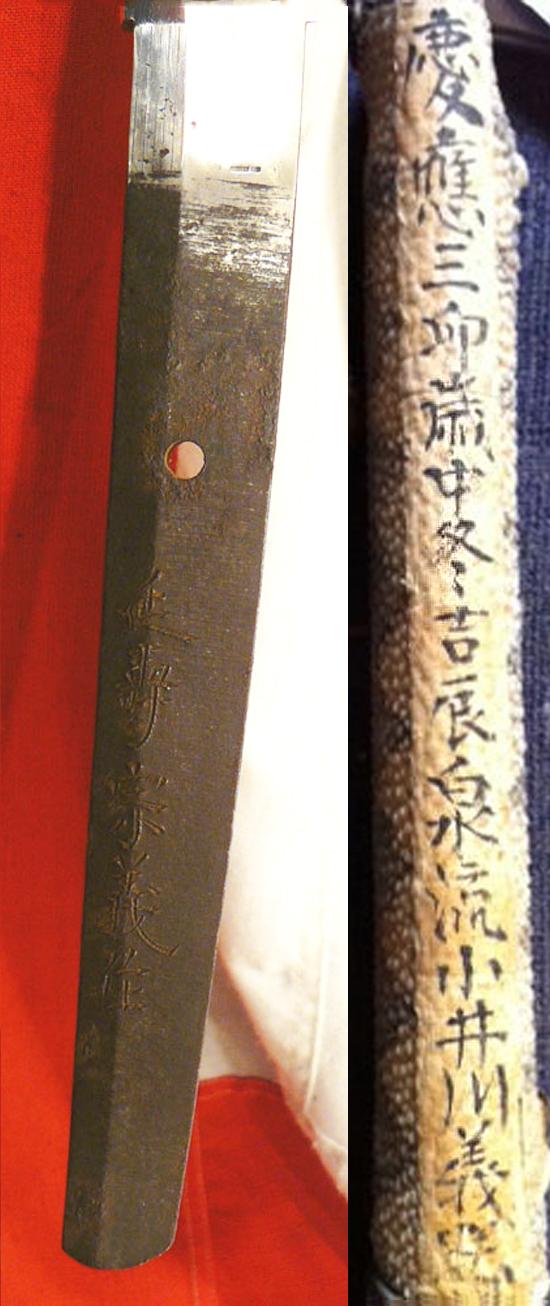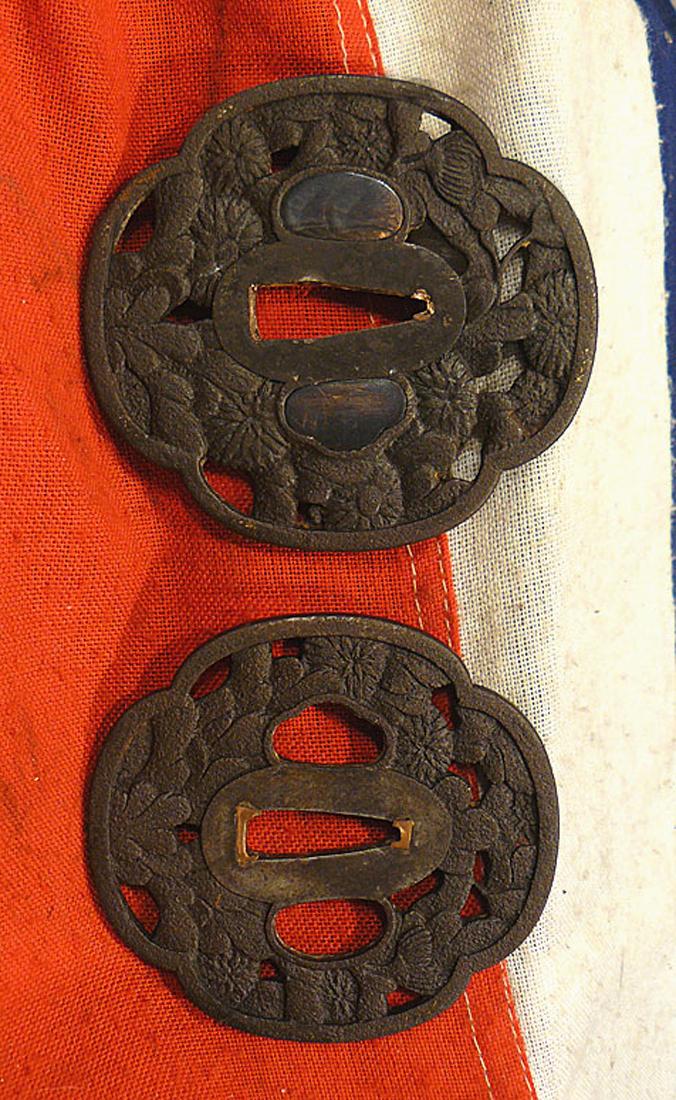A Singularly Magnificent Original Antique Presentation Daimyo Samurai Daisho. A Signed Original Edo Period Daito By Muneyoshi Presented to Yoshifuji, In the Fortuitous Time of The Midwinter, In The Year of the Rabbit, in The Reign of Emperor Keio
The fantastic shoto {short sword} is Sukesada school, koto to shinto period, the stunning daito {long sword} is a shinshinto sword signed Muneyoshi.
The shoto blade has just returned from its traditional polish and conservation that took almost a year to complete, and looks amazing.
An incredibly Beautiful original antique Edo period (1596-1871) Daisho mounted with beautifully patinated copper koshirae based on hand carved botanical designs of incredible miniscule detail, gold tsukaito, with very finest, original Edo period, decoratively embossed two tone black urushi lacquer saya.
The kodzuka is gold to match the ito and decorated with cranes. The daito has a superb midare hamon of wondrous activity. The daito is, signed Muneyoshi, the shoto is mumei {unsigned}.
The shoto has a very fine and elegant suguha hamon and now looks absolutely amazing, and was well worth the wait.
The tsuka bore an inscription, signed on a parchment see photo under the tsukaito, to date the occasion when and to whom they were presented, during the Keio Emperor's reign in 1867. the daisho was already antique when it was presented to Yoshifuji san, no doubt a daimyo of great standing.
The presentation inscription reads;
“Keio san nen usagi Yoshi Chuto Kichi no tatsu Izumi ryu Koi, Koi Kawa Yoshifuji.’
Effectively, it translates to;
Presented to Yoshifuji, In the fortuitous time of the midwinter, in the year of the rabbit, the third year in the reign of Emperor Keio. Emperor Keio died in 1868, succeeded by the Meiji Emperor..
This form of parchment inscription, concealed under the tsuka-ito, is very rare indeed and we have never seen a complete inscription such as this to survive before.
The daisho has a pair of very fine kikubana sukashi daisho tsuba with a tetsumigakiji, possibly Sunagawa Masayoshi school, Edo period.
The Sunagawa tsuba school derived from the artists trained by teachers from within the Yokoya school founded by Yokoya Somin. The Ishiguro (by way of the Sunagawa school) and Iwamoto schools had the same antecedents. The botan (peony) was a common theme in this school.
The daisho is a Japanese term referring to the traditional weapons of the samurai. The daisho is composed of a katana daito and wakizashi shoto. The daito, meaning big sword, and shoto, meaning small sword, The katana, the longer of the two swords, was typically employed in man-to-man combat. The wakizashi made an effective main-gauche or close-combat weapon. A daisho allows for defense while fighting or the fighting of two enemies. Also, the daisho allows the fighter to have a longer or more widespread fighting range. The concept of the daisho originated with the pairing of a short sword with whatever long sword was being worn during a particular time period. It has been noted that the tachi would be paired with a tantō, and later the uchigatana would be paired with another shorter uchigatana. With the advent of the katana, the wakizashi eventually was chosen by samurai as the short sword over the tantō. The ancient custom of leaving the katana at the door of a castle or palace when entering facilitated the continuing to wear the wakizashi within the host's castle.
The wearing of daishō was strictly limited to the samurai class, and became a symbol or badge of their rank. Daishō may have became popular around the end of the Muromachi period (1336 to 1573) as several early examples date from the late sixteenth century. An edict in 1629 defining the duties of a samurai required the wearing of a daishō when on official duty. During the Meiji period an edict was passed in 1871 abolishing the requirement of the wearing of daishō by samurai, and in 1876 the wearing of swords in public by most of Japan's population was banned; this ended the use of the daishō as the symbol of the samurai, and the samurai class was abolished soon after the sword ban. Picture of Last Fight of the Soga Brothers, 1858 by Kuniyoshi (1797 - 1861). Both saya have small areas of natural wear and use. The stand shown is for illustration only and not included. however it will come with another complimentary daisho stand. The shoto blade is being carefully cleaned so can be photographed later.
Special offer item, part one of a personal private collection, sourced from a former Far Eastern specialist fine samurai sword collector
Code: 24245
28995.00 GBP










